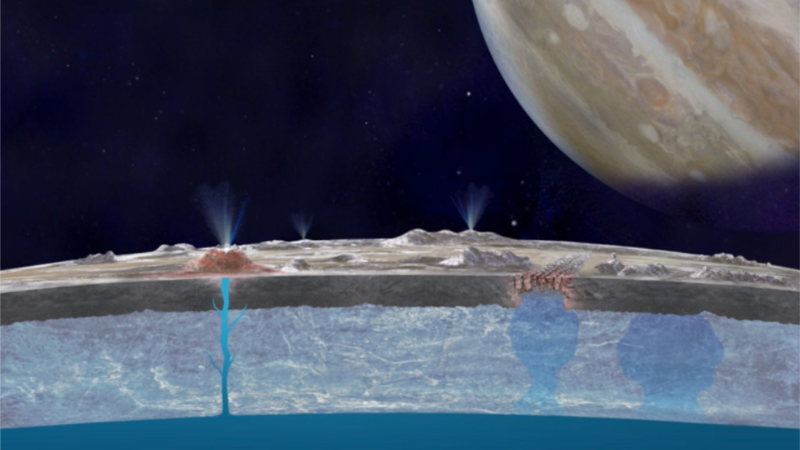Anyone versed in the arcana of science fiction knows about the significance of Europa, a moon of the planet Jupiter. Scientists have always considered it to be one of the best places in our solar system to look for life because chances are Europa has a salty, reasonably warm ocean of liquid water underneath its icy surface. It's significant to science fiction fans as well because Europa was the one place the highly advanced aliens in Arthur C. Clarke's 2001 series said humans were not allowed to visit, because it contained primitive lifeforms with evolutionary potential. The real science world of astronomy has been buzzing since last week, when NASA announced it was holding a teleconference "related to the presence of a subsurface ocean on Europa" and the Internet has been wild with speculation about everything from oceans to aliens. Well, the bad news first: it's not aliens. Deep salt water ocean The good news, announced Monday, is that it may be much easier to search for life if we get to Europa. NASA says images from the Hubble Space telescope suggest there are giant salt water geysers shooting plumes of water high into the atmosphere which rains back down to the surface. Think of it as an interplanetary Old Faithful. These plumes, if NASA can actually prove their existence, are much different than what we think of as geysers. First, they are reaching up to 200 kilometers into the atmosphere of Europa. Secondly, they aren't faithful at all. In a news conference, the scientists on the project said the plumes come and go and Hubble could only sometimes capture images of the plumes. A team also discovered some evidence of plumes back in 2012, but neither team has been able to confirm each others' work. That led the scientists at Monday's teleconference to emphasize, "We aren’t saying we have proven that plumes exist." William Sparks from the Space Telescope Institute clarified, "only that we have added to the information that suggests that they exist." How is it getting there The ocean on Europa is massive. While it is just a bit smaller than our moon, scientists believe its subsurface ocean holds about twice as much water as we have here on Earth. And the University of Georgia's Britney Schmidt, one of the researchers, isn't quite sure how the water is breaking through the ice that separates the ocean from the moon's surface. "We have lots of hypotheses to look into" she said, but added that future missions will have to confirm both the existence of the plumes and how that water is getting to the surface. That means that if we can visit and confirm the presence of these geysers, then we'll be able to study what the ocean is like by scraping geyser ice off the surface instead of having to drill through kilometers of ice to test the waters. Europa would become the second moon in the solar system known to have water vapor plumes. In 2005, NASA's Cassini orbiter detected jets of water vapor and dust spewing off the surface of Saturn's moon, Enceladus. Confirming the plumes is NASA's next job, and scientists may use the infrared vision of NASA’s James Webb Space Telescope, scheduled to launch in 2018, to confirm venting or plume activity on Europa. NASA also is formulating a mission to Europa with a payload that could confirm the presence of plumes and study them at close range during multiple flybys.
Jupiter’s Europa Moon May Have Subsurface Ocean, Huge Geysers





